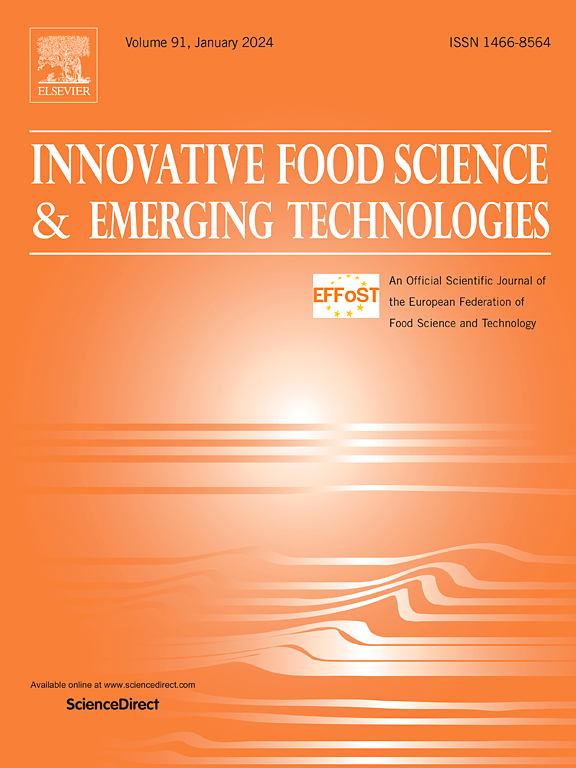增强填料密度的α-氧化铝微滤膜澄清橄榄汁
IF 6.3
1区 农林科学
Q1 FOOD SCIENCE & TECHNOLOGY
Innovative Food Science & Emerging Technologies
Pub Date : 2025-04-24
DOI:10.1016/j.ifset.2025.104031
引用次数: 0
摘要
创新设计的发展使新一代矿物膜的产生具有增强的过滤填料密度,提高了它们与聚合物膜的竞争力。研究了平均孔径为800 nm和600 nm、过滤填料密度为184 m2的两种α-Al2O3膜的性能。M−3,重点研究其操作参数和橄榄汁澄清质量。800 nm膜的过滤效率是600 nm膜的2.4倍。但在最终产品中留下了14-19 NTU的雾霾,更容易结垢。相比之下,600 nm膜产生完全澄清的果汁(<2 NTU),并且更耐污染。用两种膜澄清并没有产生29种检查的酚类化合物中的大多数的显著保留。然而,总溶解物质的7.0 - 7.5%的保留,可能是多糖胶体,并完全去除残油。两种膜都能催化自发水解反应,使酪醇、羟基酪醇和毛叶花糖苷的含量显著增加,澄清果汁中油酸苷的浓度上升了89.3%。工业相关性:新鲜橄榄汁是酚类和环烯醚萜类抗氧化剂的极好来源。然而,由于在线加工的技术困难,将其转化为增值产品对橄榄油行业来说仍然是一个挑战。这种活性的一个关键瓶颈是去除悬浮固体杂质。该研究表明,α-Al2O3微滤膜平均孔径达600 nm,能够一步澄清最少预处理(离心17568 g)的橄榄汁,并且质量很高。该处理方法可扩展用于工业应用。本文章由计算机程序翻译,如有差异,请以英文原文为准。
Clarification of olive juice by α-alumina microfiltration membranes with enhanced packing density
The development of innovative designs has enabled the creation of new-generation mineral membranes with enhanced filtration packing densities, improving their competitiveness against polymeric membranes. This study evaluates the performance of two α-Al2O3 membranes with mean pore sizes of 800 and 600 nm and a filtration packing density of 184 m2.m−3, focusing on their operational parameters and the quality of olive juice clarification. Filtration with the 800 nm membrane achieved 2.4 times higher productivity than the 600 nm membrane. However, it left 14–19 NTU of haze in the final product and was more prone to fouling. In contrast, the 600 nm membrane produced fully clarified juice (<2 NTU) and was more resistant to fouling. Clarification with both membranes didn't produce significant retentions of the majority of the 29 examined phenolic compounds. However, retentions of 7.0 to 7.5 % of total dissolved substances, likely polysaccharide colloids, and complete removal of residual oil were achieved. Both membranes were capable of catalyzing spontaneous hydrolysis reactions that produced a significant increase in the contents of tyrosol, hydroxytyrosol and verbascoside, with oleacein concentration rising by up to 893 % in the clarified juices.
Industrial relevance: fresh olive juice is an excellent source of phenolic and secoiridoid antioxidants. However, converting it into a value-added product remains a challenge for the olive oil industry due to technical difficulties in its on-line processing. A critical bottleneck of this activity is the removal of suspended solid impurities. This study shows that α-Al2O3 microfiltration membranes with mean pore sizes of up to 600 nm are able to clarify a minimally pre-treated (by centrifugation at 17568.g) olive juice in only one step and with very high quality. The treatment is scalable for industrial applications.
求助全文
通过发布文献求助,成功后即可免费获取论文全文。
去求助
来源期刊
CiteScore
12.00
自引率
6.10%
发文量
259
审稿时长
25 days
期刊介绍:
Innovative Food Science and Emerging Technologies (IFSET) aims to provide the highest quality original contributions and few, mainly upon invitation, reviews on and highly innovative developments in food science and emerging food process technologies. The significance of the results either for the science community or for industrial R&D groups must be specified. Papers submitted must be of highest scientific quality and only those advancing current scientific knowledge and understanding or with technical relevance will be considered.

 求助内容:
求助内容: 应助结果提醒方式:
应助结果提醒方式:


